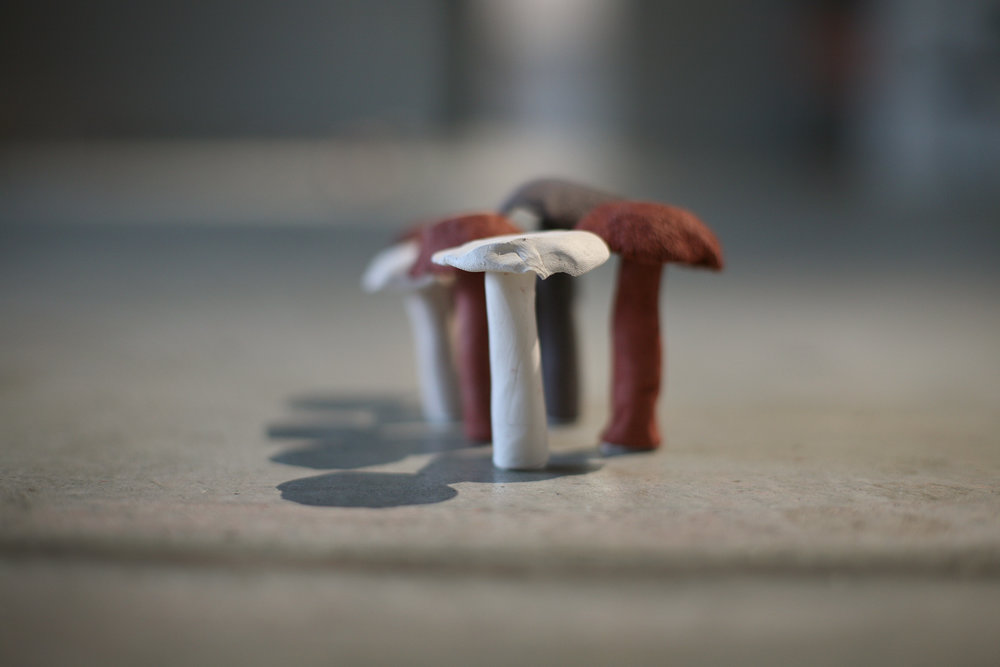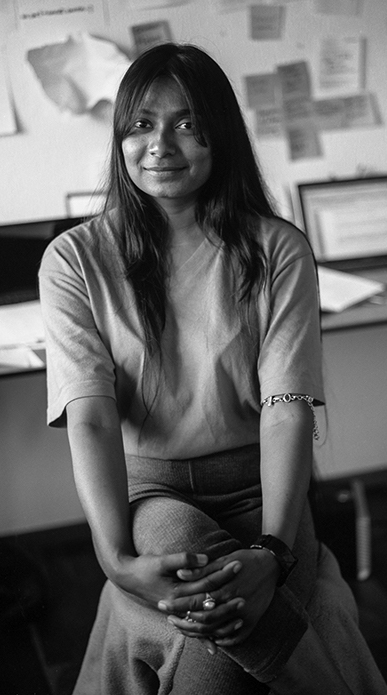Featured Event: ‘What Leaf? What Mushrooms?’ | Zurich, Switzerland
The exhibition 'What Leaf? What Mushrooms?' by Ishita Chakraborty
opens September 12th, 2019
at the 'Art Container' in Zurich, Switzerland
 The title of this artwork is inspired by the American composer and visual artist John Cage and his version of a Japanese Haiku by the seventeenth-century poet and saint Matsuo Bashō, featuring a mushroom and a leaf. Haikus are often related to the seasons: spring, summer, fall and winter.
The title of this artwork is inspired by the American composer and visual artist John Cage and his version of a Japanese Haiku by the seventeenth-century poet and saint Matsuo Bashō, featuring a mushroom and a leaf. Haikus are often related to the seasons: spring, summer, fall and winter.
The work was also inspired by the reading of ‘The Mushroom at the End of the World’ by Anna Tsing. It is said that, after Hiroshima was obliterated by an atomic bomb, “the first living thing to emerge from the blasted landscape was a Matsutake mushroom”. They only grow in human-disturbed forests and were first mentioned in an eighth-century Japanese poem celebrating “the wonder of autumn aroma”. The smell is unique, though Tsing admits most Europeans can’t stand it: “It’s not an easy smell. It’s disturbing.” During her reading, she became fascinated by the nature of mushrooms and their haphazard organic growth. Mushrooms are fungi, they are parasites, and they grow where they get food.
I started to imagine the mushrooms becoming migrants, growing and stretching all over the world. The migrants and refugees are mostly resettling from war-torn places and countries with a poor economy. It is said that they try mostly to get into Europe or they end up in the United States because that’s where they think they will find ‘quality of life’.
I am an immigrant in Switzerland.  A large part of assimilation consists of language training. Deutsch and Schwiitzer Deutsch learning, ten hours a week, has become a big part of my life, which I share with my colleagues at the Autonome Schule. It is a small world within a larger community.
A large part of assimilation consists of language training. Deutsch and Schwiitzer Deutsch learning, ten hours a week, has become a big part of my life, which I share with my colleagues at the Autonome Schule. It is a small world within a larger community.
This project is about co-existence and the attempt to make other colours and their cultures visible in the white society where I now live. It evokes the sprawl and evolvement of organic movements of human beings beyond controlled borders and immigration policies. It is the utopia of a harmonious co-existence in a Eurocentric society.
The container connects to the journeys of migrants and the life of refugees in transition. The standard shipping container has long become a symbol of globalization and the limitless transportation of goods around the world.  Whereas trade barriers have been continually reduced over the years, the movement of people, especially from the South to the North, has become increasingly restricted and difficult. To choose the extremely dangerous option to attempt a journey, locked into one of these containers, speaks for itself. The histories and lives of migrants metaphorically turn into a product, kept in storage, packaged and ready to be shipped. This work questions the role of identity, language, maps and territory, borders and restrictions, immigration, memories, co-existence and conflicts.
Whereas trade barriers have been continually reduced over the years, the movement of people, especially from the South to the North, has become increasingly restricted and difficult. To choose the extremely dangerous option to attempt a journey, locked into one of these containers, speaks for itself. The histories and lives of migrants metaphorically turn into a product, kept in storage, packaged and ready to be shipped. This work questions the role of identity, language, maps and territory, borders and restrictions, immigration, memories, co-existence and conflicts.
About the artist:
Ishita Chakraborty’s works are often autobiographical in nature and poetic. Her oeuvre is expressed through different media including unconventional drawings, installations, poetry, sculptural objects, video and photography. The artist draws the inspiration from her own family history. She grew up with her grandfather, who was an actor and director in theater throughout his life.  As a grandchild of an Art and Craft teacher, she keenly observed her grandmother’s creative embroidery, sculptural objects, crafts and her diaries.
As a grandchild of an Art and Craft teacher, she keenly observed her grandmother’s creative embroidery, sculptural objects, crafts and her diaries.
Due to her father’s job the family moved from one place to another and lately the artist immigrated to Europe. Her own journey of migration and the migration of large number of people from Bangladesh in East Bengal greatly influenced her work. Today, identity and language are the two main pillars of her work. Ishita’s work initiates a dialogue between the cultures, socio – political history and situation, a going back and forth, digging in memory and setting new priorities. Lost and found, erasing and revealing, disorientation and relocation, exile and belonging. Between homesick and homeseek!
Ishita is a West Bengal (India) born, Zurich based artist. After her MFA (2013) in Fine Arts from Rabindra Bharati University in Kolkata she won several awards and started exhibiting her work in national and international venues. In 2017 Ishita was invited in Switzerland in the studio of the Gästeatelier Krone in Aarau. She had her first solo exhibition in the Museum Forum Schlossplatz in Aarau. Parts of her work were then chosen by Kunsthaus Zofingen by curator Claudia Waldner to be exhibited in the Art for Peace group exhibition. She has presented her artist talk about Culture Clash in Dock Basel, Switzerland and in Museum Forum Schloss Platz in 2017. In 2018 she was invited to participate with the Khoj Foundation PEERS SHARE program in Delhi. She is now continuing her voyage with the MFA in Art and Media program at Zurich University of the Arts (ZHdK). In 2019 she presented her recent body of work ‘I speak your language’ in Kunstraum, Zhdk, Zurich and participated in performance art event with Reta in Zurich. Her forthcoming exhibition is in September 2019 in Art Container Zurich ‘What Leaf? What Mushroom?’.
See more of Ishita's works at Ishitachakraborty.com
